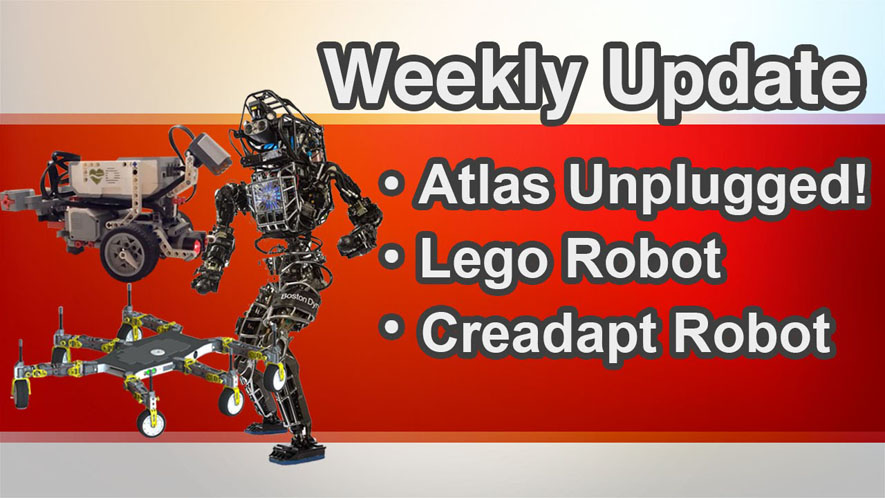Hi there and welcome to my weekly Robot Update. This is where I do a roundup of what is going on in the Robot news around the world, so stay tuned.
Hi Guys, I’m Philip English from robophil.com, and welcome to the Robot Weekly update number 11. Today we are looking at Free roaming, Worm thinking, non-stopping robots!
Atlas unplugged! DARPA’s unterminated robot cuts the power cable.
Atlas, the 6ft 2in (1.88m), 345lb (156kg) humanoid machine being used in the DARPA Robotics Challenge (DRC), has an extensive upgrade and is now free to roam on battery power alone, the defense research group has said.
The original Atlas, designed by Boston Dynamics (now owned by Google) in 2013, was an all-metal beast permanently tethered to a wall socket, but the upgraded version will carry an onboard 3.7- kilowatt-hour lithium-ion battery pack. That’s enough juice for one hour of “mixed mission” work, such as walking or using tools.
The new unit also has a hydraulic variable-pressure pump build into its torso that increases Atlas’ strength. It also is much quieter than the robot’s old pump, which was so noisy that teams had to wear ear protectors during operations. 75 percent of the robot’s original parts have been replaced or removed and part of the body shell has been replaced with plastics. Atlas carries three new “perception computers” with a wireless router for control, and has also been given more agile wrists and arms.
The DRC finals are on June 5 and DARPA has announced new rules to make the competition tougher. Atlas units will have to drive a vehicle to a test site, clear and open a rubble-strewn doorway, and break down a concrete wall. Once inside the test building, Atlas must then climb a ladder, get across a walkway, close a circular manual valve and turn on – and operate– a fire hose.
Lego robot controlled by artificial worm brain developed by OpenWorm project Artificial intelligence researchers are developing a digital version of a worm brain that can be uploaded into a LEGO robot and reproduce the creature’s thoughts and actions. The OpenWorm project is dedicated to creating the world’s first digital organism by mapping the mind – or connectome – of a Caernorhabditis (C.Elegans) worm. The aim is for the robot to mimic primitive worm behaviours like feeding, locomotion and mate-finding. However, the independently controlled LEGO robot is currently limited to obstacle avoidance. Without any prior programming the connectome is able to control the robot, while sensors allow it to react to its environment.
Ultimately, the OpenWorm project could prove that it’s possible to upload a human brain to a computer. Attempts are already underway to map the human connectome and understand its complete structural and functional neural connections, however the scale of the task is orders of magnitude larger. The OpenWorm project is still awaiting peer review but an open-source virtual model of the worm – complete with an elastic body -will be released online in June.
Creadapt: How to Make a Robot That Cannot Be Stopped
It’s been a year and a half since we watched Jean-Baptiste Mouret’s hexapod teach it self how to walk again after losing a leg. Damage resilience is certainly critical to being able to remain mobile while exploring that scary and dangerous world outside of a laboratory, but adaptation can be taken even farther, and Mouret’s new robot is exploring exactly how far that is on six adaptable wheels. On flat ground, the Creadapt robot can use its wheels. But as soon as it encounters some other surface, like dirt or grass or rocks or rubble or mysterious grey goo, it’ll change its gait to whatever is most efficient. Fundamentally, a robot losing a leg and a robot trying to move across a foreign surface efficiently is the same problem: the robot has to adapt to a new environment. To do this, the Creadapt project is teaching robots to do what animals (like humans) do. Namely, we innovate, optimize, evolve, and adapt. Or in other words, we try different things until we find what works, and then we keep trying variations on what works until we’ve found what works best.
The general philosophy here is to teach robots to be able to find their own solutions to complex problems. This is important for long-term reliable autonomy, because there’s no way that we can possibly foresee all of the different problems that a robot might run into.
That’s it guys, for a weekly world Robot News, I am your host Philip English
If you like this weekly report and want to see more of the latest Robot News, Reviews and robotic tutorials, then please hit the subscribe button, to keep up to date
I have put further information about the robots in the weekly robot update in the links below, as well as extra webs link for your review. If you have a robot product that you would like me to do a review or do a tutorials for, then please ping me over a message in the comments section and I will see what I can do.
Thanks Guys! I’m looking forward to see you next time.
Atlas Unplugged | Lego Robot | Creadapt Robot YouTube: https://youtu.be/xvvZUQr3SyI
Philip English: https://philipenglish.com
Sponsor: Robot Center: http://www.robotcenter.co.uk

